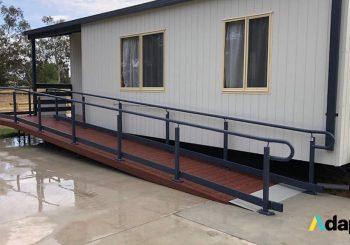Wheelchair ramps are an essential installation on both commercial and residential structures.
They give people that use mobility devices like wheelchairs, the freedom to access a building conveniently.
All commercial establishments are required to ensure there are disability ramps on their properties so that visitors, clients, and customers can access their services at their physical locations, easily. However, these ramps require planning, and if you are considering installing one, you need to plan and construct it well.
If the ramp plan and layout isn’t correct as per DDA guidelines that can make it dangerous for use. You must conduct some research, visit the DDA website, and get an understanding of what works and what doesn’t.
The more straightforward way to go about this is to contact a reliable company that offers wheelchair ramp products, built-in line with DDA guidelines. They would also provide you with all the information you need to make a more informed decision.
Aspects To Keep In View
There are several aspects to keep in view while deciding which disability ramp will work best for your property, such as:
Materials
Ramps could be made using various materials such as:
- Wood – Hardwood is incredibly resilient and can endure exposure to the elements. But it needs regular maintenance to ensure it doesn’t warp or rot. Neglecting maintenance can cause it to deteriorate and will also make it unsafe for use. Since wood tends to become slippery when wet, you need to install sand grit strips along the length of the ramp to provide traction for wheelchair and mobility device users.
- Concrete – This rough-textured surface material is commonly used in commercial ramp construction. But it might not be the right choice if you are looking for a temporary or semi-permanent ramp. Concrete ramps also need very solid ground for construction.The area will have to be prepped correctly before pouring concrete for the wheelchair ramp feature. Concrete ramp installation is far more expensive than other materials, and maintenance is costly too. Also, as mentioned earlier, it might not always be the right choice for every property.
- Aluminium – This material is widely used in residential and commercial wheelchair ramp construction. It is corrosion-resistant, lightweight, and robust. It is made with extruded sections that have inbuilt grooves which lend better traction without the need for any sand grit strips.But you can always install these for added safety in wet conditions. Aluminium is lightweight, so heavy traffic can cause it to wobble. Some companies manufacture heavy-duty aluminium wheelchair ramp products. These products can withstand the heavy traffic that commercial properties experience.
- Prefabricated aluminium – These prefabricated sections are cost-effective, and the assembly is easy. Some property owners buy the kits and handle the installation themselves. But you need to order these advances, factoring the lead time the company needs to manufacture and ship them to you.
- Colorbond Steel – This is a heavy material that is also distinctly more resilient than aluminium. Depending on the products you purchase, they can be more secure and cost-effective than aluminium sometimes.Untreated or uncoated steel is prone to rust and corrosion, and it’s why you must select modular wheelchair ramp products made of Colorbond sheets. There are various colours to choose from, and the special coating is UV-resistant and rust-resistant too. The textured surfaces help prevent slippage, making Colorbond steel ramps an ideal option for commercial and resident property owners alike.
The Cost Factor
Just as you want a ramp that is stable, resilient and long-lasting, you would also want it to be cost-effective, so it fits into your budget. When it comes to disability ramp costs, there can be a wide variation, based on factors such as:
- Location
- Material
- Labour involved
- The difficulty level of the project
Opt for The Right Ramp System
Regardless of whether you need a wheelchair ramp for your commercial or residential property, you should consider opting for ramps made using Colorbond material. These are durable and long-lasting and are easy to maintain, which means you get a good ROI.
If you opt for either a concrete or wooden ramp, there can be a wide cost difference based on the product you choose and which company you hire for the installation. But when you opt for disability ramp systems from a company like Adapta, you are assured of the perfect combination of durability, safety, aesthetics and cost. Our modular products offer you the flexibility to choose the layout you want, and our team is here to guide your choices.
The ramps are robust and can withstand heavy use but aren’t considered permanent structures. It means you do not need the kind of permits that concrete ramps need and would be able to relocate them if needed. We provide a wide variety of ramp layouts and options. You can call 1800 232 782 or contact Adapta through this form, and one of our representatives will contact you shortly.


